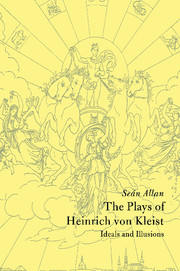1 - Introduction
Published online by Cambridge University Press: 28 August 2009
Summary
Ambiguity paradox and self-contradiction have long been regarded as the hallmark of the Kleistian œuvre. It is this formal complexity that has so aroused the interest of critics in the latter part of the twentieth century and has led some to see Kleist as a precursor of literary modernism. Not for nothing did Franz Kafka name Kleist as one of his four ‘blood’ relatives. At the same time, the rise of literary theory in the seventies and early eighties prompted a renewed and intensive interest in Kleist's work which has lasted up to the present day. Nor has this interest been confined to the world of literary criticism: many works by contemporary German authors, among them Christa Wolf, Heiner Müller and Christoph Hein, bear the unmistakable imprint of Kleist's influence. But although the volume of secondary literature on Kleist is increasing rapidly (and shows few signs of slowing down) critics still seem unable to reach any firm consensus even on some of the most basic issues. And as we shall see, not only has his work given rise to a wide divergence of critical opinion, but the critical debates it has provoked have been often bitter and uncompromising.
Few such debates can have been as fiercely contested as that between Wolfgang Wittkowski and Lawrence Ryan regarding the play Amphitryon. Indeed the Wittkowski–Ryan exchange highlights many of the difficulties with which any critic dealing with Kleist's work is confronted, not the least among which is the fact that the text appears to offer readings that are, at first sight, diametrically opposed to one another.
- Type
- Chapter
- Information
- The Plays of Heinrich von KleistIdeals and Illusions, pp. 1 - 12Publisher: Cambridge University PressPrint publication year: 1996
- 1
- Cited by

